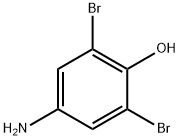| Identification | More | [Name]
4-AMINO-2,6-DIBROMOPHENOL | [CAS]
609-21-2 | [Synonyms]
2,6-DIBROMO-4-AMINOPHENOL
3,5-DIBROMO-4-HYDROXYANILINE
4-AMINO-2,6-DIBROMOPHENOL
ASISCHEM U70323
TIMTEC-BB SBB006577
4-amino-2,6-dibromo-pheno
Phenol, 4-amino-2,6-dibromo-
4-hydroxy-3,5-dibromoaniline
1-CYANO-3,5-DIBROMO-4-HYDROXYBENZENE | [EINECS(EC#)]
210-185-1 | [Molecular Formula]
C6H5Br2NO | [MDL Number]
MFCD00007874 | [Molecular Weight]
266.92 | [MOL File]
609-21-2.mol |
| Safety Data | Back Directory | [Hazard Codes ]
Xi | [Risk Statements ]
R36/37/38:Irritating to eyes, respiratory system and skin . | [Safety Statements ]
S26:In case of contact with eyes, rinse immediately with plenty of water and seek medical advice .
S37/39:Wear suitable gloves and eye/face protection .
S36:Wear suitable protective clothing . | [WGK Germany ]
3
| [TSCA ]
Yes | [HazardClass ]
IRRITANT | [HS Code ]
29222900 |
| Hazard Information | Back Directory | [Chemical Properties]
beige to pale brown crystalline powder | [Synthesis]
The synthesis of 4-amino-2,6-dibromophenol is as follows:4-Nitro-2,6-dibromophenol (2.97g, 10mmol) was dissolved in ethanol (15ml) and water (3ml), and acetic acid (1ml) was added. Then heat and stir to raise the temperature to 80°C, and add iron powder (1.68g, 30mmol) in batches. After the addition is complete, the reaction solution is kept warm for 30 minutes, heating is stopped, filtered while hot, the filtrate is concentrated under reduced pressure, then ethyl acetate and water are added to the concentrated residue to extract, the organic phases are combined and dried, filtered, and the solvent is removed under reduced pressure. The residue was finally separated by column chromatography (ethyl acetate/petroleum ether=1/3) to obtain 4-amino-2,6-dibromophenol (2.52g, 94.4% yield). |
|
|






